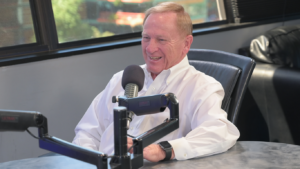April is Foot Care Awareness Month, and St. Luke’s Medical Center is using the occasion to bring greater attention to one of the most debilitating foot ailments in the U.S. – treating bunions.
Typically brought on by ill-fitting shoes and high heels, bunions are especially common among women, who are 10 times more likely to get bunions than men.
According to the Centers for Disease Control & Prevention, approximately 5.2 million people are plagued with bony bumps that develop at the joint of the big toe, which can lead to progressive pain, including dull joint aches, painful toes and throbbing pressure on the ball of the foot, as well as difficulty walking.
While comfortable, roomy shoes, protective patches, and ice can ease pressure on the foot and relieve bunion pain and inflammation, surgery tends to be the only solution to achieve more permanent relief.
St. Luke’s Medical Center’s leading podiatric surgeon, Dr. Daniel Schulman, is helping to revolutionize bunion surgery, offering patients an innovative and natural solution that allows for regeneration of the area instead of implanting screws or metal plates. “It is the same bone graft we used for decades safely as a bone void-filler (e.g., paste/putty),” said Dr. Schulman. “Now it can be used effectively in this form as a fixation device.”
During the past seven years, Dr. Schulman pioneered the use of human allograft cortical bone implants in all types of bunionectomy procedures, a revolutionary alternative to temporary and permanent metal implants (such as screws/plates and wires). Unlike metal implants, these implants fully incorporate with a patient’s bone, and do not need to be removed. As a result, patients experience less pain and swelling, have improved healing, and are at less of a risk for infection. “Even absorbable fixation devices that are synthetic can develop a sterile abscess, which mimics infection and leads to a complex removal,” said Dr. Schulman.
According to Dr. Schulman, implanting screws or metal plates to correct a bunion can create a host of potential issues – from failed hardware, metal allergy and increased risk of infection, to pain from poor positioning and the potential for a fracture. “There is one significant advantage to using these osteobiologic implants other than their biocompatibility,” he said. “These implants have a very forgiving surgical implantation, which gives the opportunity to re-drill intraoperatively through an undesirably-placed implant to insert another implant without bone loss or fracture.”
St. Luke’s Medical Center is the only hospital in Arizona using this innovative procedure to treat bunions, and is one of only a few hospitals in the country currently utilizing this advanced regenerative solution. A strong believer in the power of osteobiologics, Dr. Schulman is the only surgeon in Arizona to use this type of fixation in many types of common forefoot reconstructive procedures (which is not limited to the bunionectomy).
Incorporating the use of allograft cortical bone pins and nails in foot reconstruction is just one of the most recent advances that St. Luke’s Medical Center has embraced. The hospital has a long history of innovation. It was the first hospital in the Valley to perform open heart surgery, and is often one of the first hospitals in the state to introduce new technologies, labs and procedures. At the heart of each medical advancement is the desire to achieve even better patient outcomes.



